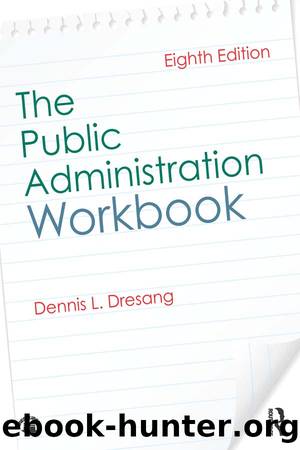The Public Administration Workbook by Dennis L. Dresang

Author:Dennis L. Dresang [Dresang, Dennis L.]
Language: eng
Format: epub
Tags: Political Science, Public Affairs & Administration
ISBN: 9781134816156
Google: CMPLDAAAQBAJ
Goodreads: 31381034
Publisher: Routledge
Published: 2008-02-01T00:00:00+00:00
KEY STEPS IN EMERGENCY MANAGEMENT
Although emergency management is necessarily ad hoc and specific to each situation, there are some key steps that must be taken to maximize the chances of an effective response:
1.
Designate an incident commander. Most states have designated the chief of the community fire department as the incident commander in emergencies, although the public health officer is the incident commander if the emergency is bioterrorism or is fundamentally a biological threat. The most important point is that someone needs to take responsibility as the one in charge.
2.
Establish a command center. The command center is in part a place where agencies, private organizations, volunteers, the media, and others can go to get information and instructions. The command center is also a steering committee that consists of representatives of key, relevant organizations and serves to advise and work with the incident commander.
3.
Communicate
a.
Internally. The agencies and volunteers participating in the response need both the technology and the organization to facilitate communication with the incident commander and with each other. A major problem confronted by responders to the emergencies of 9/11, Hurricane Katrina, and many of the shooting incidents is that the various police, fire, and health emergency forces have had incompatible cell phones and radios. Communication must be clear and allow for immediate reception of urgent messages.
b.
Externally. The public generally and the individuals most affected need to be kept informed. It is generally useful to have a mayor, governor, or some other elected political official talk with the media, even though this official is not the actual incident commander. Messages inevitably will be sent on social media. The challenge is to be sure information is accurate and instructions to the public are coordinated.
4.
Contain the problem. A fundamental responsibility of police departments is to cordon off an area, both to keep a problem from spreading and to restrict access to those who need to provide relief. Public health crises may require a quarantine of affected individuals.
5.
If relevant, apprehend perpetrators. Another responsibility of the police is to issue alerts, conduct investigations, and apprehend those responsible for disasters. Besides holding these people responsible for their acts, there is a concern about repeated incidents.
6.
Rescue and treat victims. Treatment can be obvious first aid for those affected by a disaster. Treatment may also require careful diagnosis and then a prescription for what needs to be done. Where there is uncertainty and the need for medium- to long-term treatment, it is essential to identify and contain victims.
7.
Provide immediate relief. Individuals who have lost their homes, cannot return to their jobs, or are separated from their family are examples of cases in which there is a need for immediate relief. FEMA has resources and authority for distributing limited immediate relief. The Red Cross is federally chartered to provide emergency shelter and provisions.
8.
Restore basic infrastructure and services. Individuals and communities are heavily dependent on electricity, water, transportation, and the like. If these services and facilities are disrupted, it is essential to restore them as quickly as possible. This can affect rescue operations as well as recovery efforts.
Download
This site does not store any files on its server. We only index and link to content provided by other sites. Please contact the content providers to delete copyright contents if any and email us, we'll remove relevant links or contents immediately.
The Secret History by Donna Tartt(18849)
The Social Justice Warrior Handbook by Lisa De Pasquale(12142)
Thirteen Reasons Why by Jay Asher(8796)
This Is How You Lose Her by Junot Diaz(6794)
Weapons of Math Destruction by Cathy O'Neil(6146)
Zero to One by Peter Thiel(5686)
Beartown by Fredrik Backman(5599)
The Myth of the Strong Leader by Archie Brown(5425)
The Fire Next Time by James Baldwin(5249)
How Democracies Die by Steven Levitsky & Daniel Ziblatt(5128)
Promise Me, Dad by Joe Biden(5087)
Stone's Rules by Roger Stone(5026)
A Higher Loyalty: Truth, Lies, and Leadership by James Comey(4845)
100 Deadly Skills by Clint Emerson(4840)
Rise and Kill First by Ronen Bergman(4704)
Secrecy World by Jake Bernstein(4646)
The David Icke Guide to the Global Conspiracy (and how to end it) by David Icke(4625)
The Farm by Tom Rob Smith(4438)
The Doomsday Machine by Daniel Ellsberg(4416)
